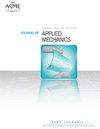Characterizing the adhesion between thin films and rigid substrates using DIC-informed inverse finite elements and the blister test
IF 2.8
4区 工程技术
Q2 MECHANICS
引用次数: 0
Abstract
Characterizing the adhesion between thin films and rigid substrates is crucial in engineering applications. Still, existing standard methods suffer from issues such as poor reproducibility, difficulties in quantifying adhesion parameters, or overestimation of adhesion strength and fracture energy. Recent studies have shown that the blister test (BT) is a superior method for characterizing adhesion, as it provides a quantifiable measurement of mix-mode fracture energy, and it is highly reproducible. In this paper, we present a novel method to characterize mechanical mix-mode adhesion between thin films and rigid substrates using the BT. Our method combines the full triaxial displacement field obtained through Digital Image Correlation with inverse Finite Element Method simulations using Cohesive Zone Elements. This approach eliminates the need for making any mechanistic or kinematic assumptions of the blister formation and allows the characterization of the full traction-separation law governing the adhesion between the film and the substrate. To demonstrate the efficacy of this methodology, we conducted a case study analyzing the adhesion mechanics of a polymeric pressure-sensitive adhesive on an aluminum substrate. Our results indicate that the proposed technique is a reliable and effective method for characterizing the mix-mode traction separation law governing the mechanical behavior of the adhesive interface and could have broad applications in the field of materials science and engineering. Also, by providing a comprehensive understanding of the adhesion mechanics between thin films and rigid substrates, our method can aid in the design and optimization of adhesively bonded structures使用DIC告知的逆有限元和泡罩试验表征薄膜和刚性基底之间的粘附性
表征薄膜和刚性基底之间的粘附性在工程应用中至关重要。尽管如此,现有的标准方法仍存在再现性差、难以量化粘附参数或高估粘附强度和断裂能等问题。最近的研究表明,泡罩试验(BT)是表征附着力的一种优越方法,因为它提供了混合模式断裂能的可量化测量,并且具有高度的可重复性。在本文中,我们提出了一种使用BT来表征薄膜和刚性基底之间的机械混合模式粘附的新方法。我们的方法将通过数字图像相关获得的全三轴位移场与使用内聚区单元的逆有限元法模拟相结合。这种方法消除了对泡罩形成进行任何机械或运动学假设的需要,并允许表征控制膜和基底之间粘附力的完全牵引分离定律。为了证明这种方法的有效性,我们进行了一个案例研究,分析了聚合物压敏粘合剂在铝基板上的粘合力学。我们的结果表明,所提出的技术是一种可靠有效的方法,可以表征控制粘合剂界面力学行为的混合模式牵引分离定律,并在材料科学和工程领域具有广泛的应用。此外,通过全面了解薄膜和刚性基底之间的粘合力学,我们的方法可以帮助设计和优化粘合结构
本文章由计算机程序翻译,如有差异,请以英文原文为准。
求助全文
约1分钟内获得全文
求助全文
来源期刊
CiteScore
4.80
自引率
3.80%
发文量
95
审稿时长
5.8 months
期刊介绍:
All areas of theoretical and applied mechanics including, but not limited to: Aerodynamics; Aeroelasticity; Biomechanics; Boundary layers; Composite materials; Computational mechanics; Constitutive modeling of materials; Dynamics; Elasticity; Experimental mechanics; Flow and fracture; Heat transport in fluid flows; Hydraulics; Impact; Internal flow; Mechanical properties of materials; Mechanics of shocks; Micromechanics; Nanomechanics; Plasticity; Stress analysis; Structures; Thermodynamics of materials and in flowing fluids; Thermo-mechanics; Turbulence; Vibration; Wave propagation

 求助内容:
求助内容: 应助结果提醒方式:
应助结果提醒方式:


